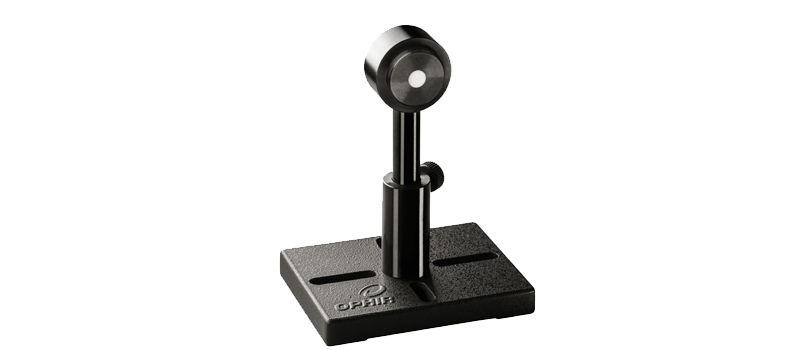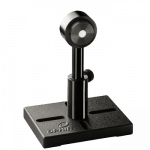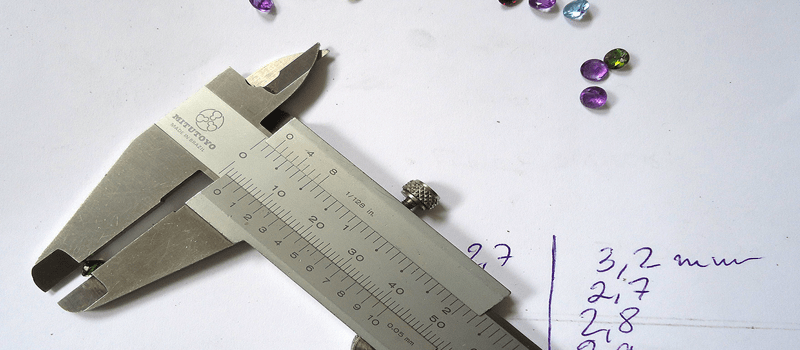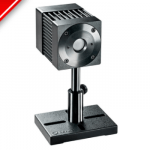By Dick Rieley, Sales Manager, Mid Altantic and Southeast Regions, Ophir-Spiricon LLC
The selection of a sensor to accurately measure the power of a laser or energy of a pulsed laser can seem like a simple and easy procedure. However, many times the selection process is limited to choosing a sensor that only meets the range of power or energy to be measured, leaving out several other essential criteria of the laser specifications; that without their consideration, can allow the wrong sensor to be selected, the laser to be measured inaccurately and likely to cause the sensor to fail prematurely.
With the attention to a few key parameters of the laser source; the selection of the best sensor can be optimized for accurate measurements of the laser, long life of the sensor and operational satisfaction for the user.
Step #1
Before a laser power or energy sensor can be selected; the operational characteristics of the laser source must be identified. Without this information, the incorrect sensor will be selected.
Identify the key elements of the laser source, regardless of the type of measurement or sensor required;
Wavelength-what is the wavelength(s) of the application. Certain sensors are wavelength specific; others are considered Broad Band and can function at a full range of wavelengths without restriction. Understanding what wavelengths the sensor will be required to absorb is necessary.
Beam Diameter-the size of the beam to be measured is the next key element. This dimension will determine the sensor aperture size, or if too large would require a beam reducing lens; or if too small ( in the um’s, would require a beam expanding lens. It is always preferred to use a sensor with an aperture size sufficient to contain the entire beam without additional optics. Caution: when selecting a sensor based on the laser beam size, do not choose a sensor (for example) with a 10mm aperture for a laser source that has a 10mm beam. Always choose a sensor size that is at least 10% and preferably 30% greater than the size of the laser beam to allow for ease of alignment and positioning of the beam. Should the beam be too large for the sensor aperture, clipping part of the beam off the sensor surface will cause inaccurate measurements, causing the sensor to read low, as well as possibly damaging the sensor face plate.
It is not uncommon to choose to measure power or energy at the focal spot of the laser beam. Typically when selecting a sensor, this location for the measurement is NOT an option. The power or energy density of the beam at this focal point is at such a value, that the specification of nearly any sensor will be exceeded, and if conducted will immediately damage the sensor’s absorber. The recommendation for positioning the sensor for accurate and safe measurement is either prior to focus or after focus, where the average power is equal to that AT focus, but the power or energy density is within the limits of the sensor.
CW or Pulsed – it is important to determine if the laser is (CW) continuous wave, or pulsed. With pulsed laser sources, the damage threshold of the beam and the prospective sensor’s surface become major considerations in the selection of a sensor.
CW Lasers – Continuous wave lasers are measured using average power; nW, to kW’s. When selecting a sensor for a CW laser, the range of average power to be measured needs to be identified. This range will be important in the choice of a sensor that has a similar range; If this range is too large, then a 2nd sensor will be required; one for the high end of the range, and a 2nd for the low end of the range. Also, it is important to select a sensor that the range to be measured is near the middle of the sensor’s specified range – not at the low end or the high end of the sensor’s range, as this may cause inaccurate readings should the range be exceeded in either direction. Example; if a laser range is 200mW to 10w, then selecting a sensor with a range from 20mW to 10W may be sufficient. If however, measurements at 10w will be required, and possibly may require extended exposure on the sensor, then using a 10w sensor for a 10w measurement is not recommended. Moving up to the next larger sensor, such as one that has a range from 2mW to 12w and one with more mass to dissipate the heat would be a more prudent selection.
CW Laser – Exposure Time – another aspect of selecting a sensor for a CW laser beam is the duration the laser beam will be on the sensor. If the application only requires periodic measurements, and exposure time on the sensor long enough to obtain a stable average power measurement, i.e.; 10’s of seconds; then this may allow for the selection of a smaller, less expensive sensor. If, however, the application requires the laser to be exposed to the power sensor for 10’s of minutes to possibly hours, then a larger sensor with sufficient mass is needed to help dissipate any heat build-up during the measurement term that could adversely affect the measurements. In this case either a larger sensor with air-fins or even one with a built-in fan to continuously cool the sensor would be required.
Pulsed Lasers – With a pulsed source, (as with the CW laser) it is important to determine the range of energy measurements required. The selection of an energy sensor has the same requirements as an average power sensor, in that the sensor selected should easily cover the full range of the laser’s requirements, with the desired measurement range falling within the middle of the sensor’s specified range.
Pulse Rate – With a pulsed laser, it is important to identify the (pps) pulses per second, or pulse rate of the laser. This pulse rate will determine if an energy sensor can be used for this application, or an average power sensor required. Most energy sensors can easily operate from 1hz to 5khz, with several of the advanced sensors handling up to 25khz. If the application requires a pulse rate that exceeds the range of an energy sensor, then the only choice is to select an average power sensor. If the pulse rate is too fast for a typical energy sensor, and an average power sensor is needed, then the average power of the laser must be identified; this is easily accomplished using a simple formula; Energy (Joules) x Time (pps) = Power (watts). Example: if a pulsed laser has a 30khz pps spec, at 1mJ/pulse energy this equals 30 watts of average power. This would say to select a 30-40w average power sensor.
Pulse Width – With a pulsed laser, another key element is defining the pulse width ( or pulse length ) of the laser pulses. This specification has a major impact upon the damage threshold of the sensor selected. If the pulse width is too short, pS, nS’s, the energy density may exceed the rating of a particular sensor; if too long, 10’s of mS’s, then the sensor may not have sufficient integration time in its electronic circuitry, and consequently will not function properly. Again the alternative solution may be to use an average power sensor.
Once the laser criteria are known, then move onto Step #2.
Step #2
Identify the type of measurement required by the application. There are 3 types of measurements to choose from, depending upon the requirements of the laser’s process.
Average Power – Most all lasers, regardless of CW or Pulsed, can be measured with a power sensor, giving an Average Power Measurement value. This approach is sufficient to give a good indication of the ‘average’ power of the sensor. It is important to know that sensors that are designed to measure average power, have a response time of 200uS to several seconds. This means that it takes this amount of time once the laser source targets the sensor to get a valid, accurate response. For CW laser sources, an average Power sensor is the only option. With a pulsed laser, energy per pulse as well as average power measure is possible, but the real pulse to pulse performance of the laser is homogenized into average power, and the real performance detail of the laser’s stability is lost. It is important to remember that when an average power sensor is used on a pulsed laser, important performance detail on the stability of the pulses is lost. Example; for a 20hz pulsed laser operating at 200mJ of energy, (equates to 4w of average power ) when used with an average power sensor is homogenizing as many as 20 pulses to provide a 2w measurement. As a result the detail of the energy performance is not obtainable.
Energy Measurement-in most cases pulsed laser can be measured using a pyroelectric sensor that measures each pulse. This approach provides the most exacting performance detail of the laser’s activity. The choice of a sensor for this purpose, however, can be affected by many of the factors as defined in Step 1. As energy sensors can be slightly more expensive than average power sensors; but are much more informative as to the actual trend analysis of the pulse-to-pulse performance of the laser from measurement to measurement. It is recommended when working with a pulsed laser to consider an energy sensor first before deciding upon an average power sensor.
Single Shot-Energy Measurement-another type of energy measurement is Single Shot. This is one pulse of the laser that is spaced at least 5 seconds apart. If this is required, then this approach will also determine the sensor required. Both energy sensors and most average power sensors offer this measurement option.
Step #3
Once information on the laser has been identified and the type of measurement decided upon that best meets the application requirements, there are several sources for the solution.
Contact Ophir-Spiricon with this information for a list of options
Use the Ophir-Spiricon on-line (SFP) Sensor’s Finder Program; a software program that allows the information gathered above to be entered and upon clicking the Search button, offers the best choices starting with the least expensive options first.
Download the no charge (SFP) Sensor’s Finder Program from the Ophir-Spiricon website, and conduct the search at the convenience of the application engineer.
Helpful Hint with the (SFP) Sensor’s Finder Program; one key calculation that is provided by this program is the Percent of Damage Threshold. Once the characteristics of the laser to be measured are keyed into the program, and Search clicked, the sensor options will appear. Also shown is a percentage value, listed as Percent of damage threshold. The importance of this calculation is that it provides a quantitative value as to how close to damage any particular sensor is based on the laser specification inputted into the program.
Remember; 100% damage threshold = absolute damage to the sensor; The lower the value the better. It is recommended to be cautious and not to exceed 60% of the damage threshold value for any one selection. If this is not possible, then either increase the size of the beam in the SFP or reduce the energy value in SFP. Then reclick on Search.
You might also like to read:
Choosing The Right Laser Power Or Energy Sensor Is Easier Said Than Done










Leave a Reply
Your email address will not be published. Required fields are marked *